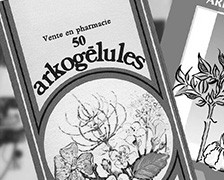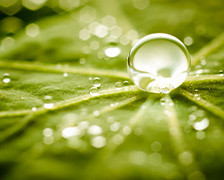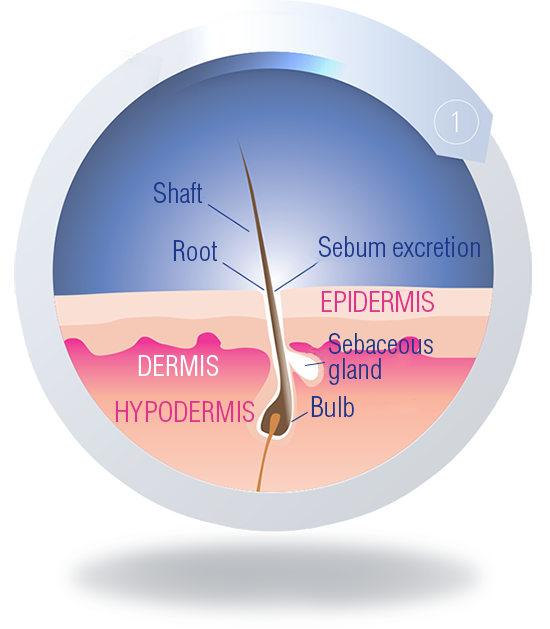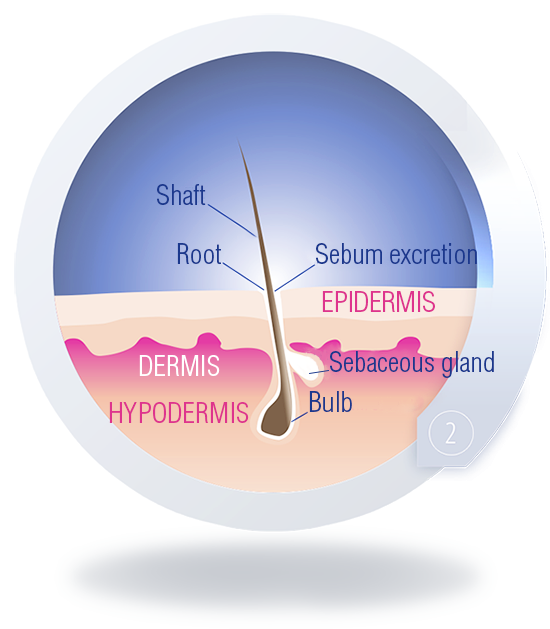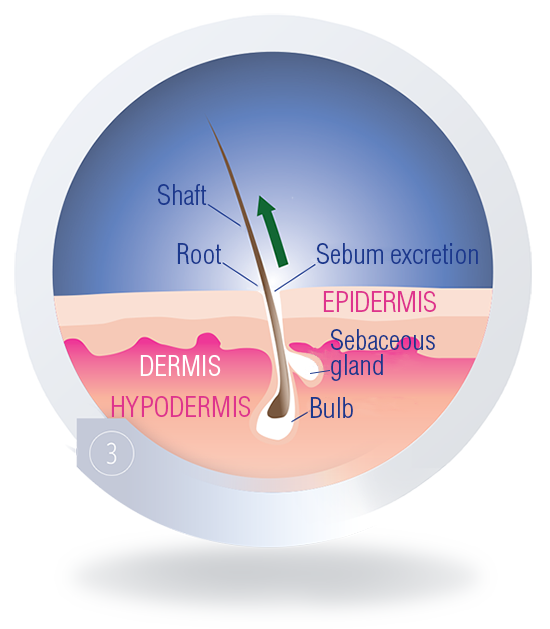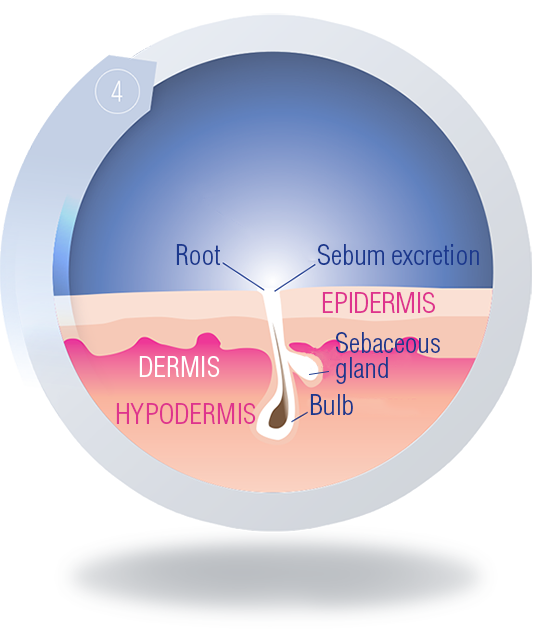
Our hair constantly renews itself. The average hair life cycle for men lasts 3 years. For women, the cycle is longer, varying between 4 and 5 years. Every hair grows continuously throughout this period. When a hair dies, it is immediately replaced by another one. But dead hair does not fall out immediately, and is only definitively ejected from the hair follicle after 2 or 3 months.
The hair life cycle
Between 25 and 30 hair life cycles are genetically programmed in the course of a lifetime.
Hair structure
Do you know what determines this very particular property of your hair? Hair volume is a timeless and universal source of seduction. A full, luxurious head of hair appeals to both men and women. On average, there are between 120,000 and 150,000 individual hairs in a head of hair.
Density and diameter
Hair volume is determined by density, or the number of hairs on your head and their thickness, i.e. their diameter.
Hair density is determined by the number and the activity of hair follicles. The higher the number of follicles, the higher the possible number of individual hairs and the greater the density of the hair. Conversely, thinning hair is the result of fewer hairs being produced by the follicles.
Hair diameter can vary from 50 to 100 micrometres (between 100 and 200 hairs are necessary to obtain a thickness of 1 cm). Together, your individual hairs will form a thick, medium or thin head of hair. However, it is possible to have fine individual hairs and a dense head of hair, or thick individual hairs and a thin head of hair.
Did you know?
On average, we lose 30 to 60 hairs a day, but this is nothing to worry about. This is part of natural cycle to regenerate our hair. Sometimes, we can lose more than 100 hairs per day. But this is not a cause for concern either. For example, we tend to lose more hair in the autumn. Hormonal variations, for example during pregnancy or the menopause, can also result in hair loss. But if you have the impression that you are suffering from excessive hair loss, then ask your doctor for advice.
While hair strength is conditioned by the structure of its cortex, permeability, shine, softness and ease of styling are mainly determined by the condition of the cuticle. Hair grows from the root at an average rate of 1 centimetre per month. The tip of a 30 cm-long hair is therefore 30 months old. This means it has been under attack for two and a half years, during which the appearance of the cuticle has changed considerably.
Smooth and cylindrical cuticles
The cuticle is the external layer of each hair and gives the hair its texture and shine. A healthy cuticle is smooth: its scales, which are new at the root, are regular and perfectly joined like the slates on a roof, enabling the hair to reflect light and limit friction with other hair shafts. The play of light is also affected by the more or less cylindrical shape of the hair.
Cuticles are made up of six to eight layers of overlapping flat cells. They are enclosed in an invisible and impermeable oily coating that acts like a natural hair conditioner.
The further the scales are from the scalp, the more they appear to be eroded. Initially, they show signs of scratching and torn edges. They then become detached from one another. Some scales disappear and may be partially or totally absent at the tip, leaving the body of the hair exposed. Worn scales compromise the uniformity of the surface and shape. Reflections of the light are reduced and the hair becomes dull.
Did you know?
Cuticles are enclosed in an invisible and impermeable oily coating that acts like a natural hair conditioner.
Hair is unbelievably strong. Each individual hair can carry 100 grams, meaning that an average head of 120,000 hairs could withstand 12 tonnes if the scalp were strong enough!
The cortex: the core of the hair
The cortex can be stretched by about 30% without suffering any significant damage. This is made possible by the surprising organisation of the keratin in the cortex. Keratin is a fibrous protein that is particularly rich in sulphur-containing amino acids.
The composition and the arrangement of its constituent filaments make this protein particularly rigid. Keratin can adopt different structures. For example, the keratin in the cells of the epidermis around the eye is different from the keratin in hair or nail cells. It contains significant proportions of:
- sulphur-containing amino acids (cystine and methionine) that enable bridges to form between the keratin fibres, making them more stable,
- minerals and trace elements (calcium, zinc, magnesium, silicon, etc.) that strengthen hair and make nails harder and stronger.
Keratin, the hair's cement, becomes fragile when our hair is dried at excessively high temperatures, permed or straightened, or repeatedly colour-treated. Sunlight, seawater, pollution and a poor diet can also cause keratin to age prematurely. Consequently, the weakened keratin can no longer keep our hair strong.
Did you know?
Weakened keratin can no longer keep our hair strong and our hair becomes brittle.
Keratin is the main component of hair, which also contains water, lipids and traces of mineral elements and melanin. The cortex is organised along the same lines as a rope or a cable.
Hair protein: keratin
The keratin in the cuticle, or the outermost part of a hair, is organised in the form of scales, arranged like the tiles on a roof. Keratin is a surprisingly strong natural fibre, measuring no more than one tenth of a millimetre in thickness. It is even stronger than an equal weight of steel! There are two types of keratin in the cortex: a twisted, vertical fibre that follows the axis of the hair and makes it so elastic, and a second horizontal fibre that links the vertical fibres to one another, providing strength and cohesion.
Keratin also gives hair its plastic properties, since hair keeps the shape we give to it for a certain length of time. For example, if you roll a straight hair around a pen for a few hours, it will remain curled, before gradually returning to its initial shape.
The shape of the chains of keratin and the nature of the bonds in these chains are two factors that determine the shape of hair. The nature of the bonds is acquired by the root in the bulb and preserved by the hair as it grows. Nature strives for perfection right to the tips of our hair by producing an assembly that combines suppleness and strength.
Did you know?
Keratin is a surprisingly strong natural fibre. It is even stronger than an equal weight of steel!
Split ends, hair that is rough and hard to detangle... Since our sense of touch is highly advanced, we can perceive the condition of the scales of the cuticle without even really realising. If they are in a good state, then the hair feels soft. Damaged scales make the hair feel rough.
A matter of scales...
Loose scales from weakened hair become attached to the neighbouring hairs, causing the hairs to become entangled and resulting in the formation of knots that become even tighter when we try to comb them out.
Crimping hair makes use of the detachment of scales. Combing hair from the tip to the root causes the scales to become detached and the hair to become entangled, so that it keeps its crimped appearance.
The cuticle often disappears at the ends of the hairs, leaving the cortex completely exposed. Without any protection, the cortex is unable to retain any humidity and divides into small parts, or split ends.
Did you know?
Loose scales from weakened hair result in the formation of knots.
Since ancient times, a fine head of hair has been perceived as a sign of beauty that adds to a woman’s powers of seduction.
Hair... A powerful weapon of seduction through the centuries and across civilisations
Beauty, shine, softness and sometimes colour all play an essential role, not to mention the body language involved in hairstyling rituals or fingers run through hair…
Greek mythology celebrates the luxuriant hair of its goddesses, from Aphrodite concealing her nudity with her long blond hair to Venus dressing her hair surrounded by the Graces, or Ariadne seducing Bacchus with her beautiful hair floating in the wind.
The oldest sources on the subject of hair date back to ancient Egypt, 4,000 years ago, where women wore grand wigs to appear more erotic and seductive.
Hair has a special place in almost every civilisation, often related to intimacy, seduction, modesty or sexuality. Our relations with others through our hair (brushing, cutting, delousing, etc.) can also be interpreted as signs of affection and caring.
Did you know?
Beauty, shine, softness and sometimes colour all play an essential role, not to mention the body language...
There are between 100,000 and 150,000 individual hairs in a head of hair. Our hair is nourished by our blood, which draws the nutriments necessary for it to develop from our food.
Vitality: a question of irrigation
Hair is planted in our scalp like a plant in the earth. The bulge at the base is called the hair bulb. Active hair growth takes place within this bulb. It is surrounded by nerves and blood capillaries, where the cells can find the specific nutriments required for their growth and differentiation. Consequently, these nutriments (amino acids, vitamins, minerals and trace elements) must be present in the blood in sufficient quantities.
Hair grows faster when properly irrigated. Our hair faces a number of ordeals in the summer. Sea salt dries the capillary envelope around the hair by absorbing the water it contains. And other drying factors, such as chlorine, wind and sand, also damage the protective keratin layer.
Did you know?
Hair grows faster when properly irrigated. Our hair faces a number of ordeals in the summer. Sea salt dries the capillary envelope around the hair by absorbing the water it contains. And other drying factors, such as chlorine, wind and sand, also damage the protective keratin layer.
The scales are damaged and the hair loses its vitality, becoming dry, porous and brittle.
